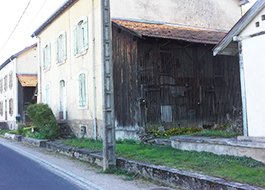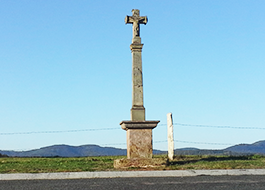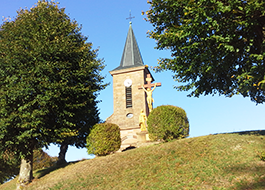Saint-Michel-sur-Meurthe
Durée visite : 40 minutes
Moyen : Pédestre
Saint-Michel est une communauté du haut ban d’Étival, happée dans l’orbite économique de Saint-Dié très tôt, bien avant le XVe siècle. Elle a dépendu tant en justice qu’en administration de l’abbaye et du chapitre prémontré d’Étival.
L’unité de la commune s’est faite autour d’une chapelle sur une éminence, le Belmont.
Le nom de Belmont fut repris pour désigner la commune sous la Révolution. La chasse aux termes religieux battait alors son plein.
En 1840, on compte 1495 habitants vivant dans 230 maisons. Les 1554 ha du territoire communal se divisent en terres labourables, prés, bois, jardins et vergers. À côté des activités de culture fournissant céréales, pois, lins, chanvre, sarrasins, pommes de terre, l’élevage traditionnel alimente en partie le commerce de bétail. Cinq moulins à grains et un actif commerce de bois sont présents dans la commune, traversée par la route Épinal-Saint-Dié. La carrière de rhyolite à Bréhimont pourvoit les pierres dures pour la réfection de la chaussée. L’école communale accueille 102 élèves, une école privée 190 enfants.
Pendant la guerre de 1870, le 5 et 6 octobre, les Prussiens envahissent la région. Une description de ces combats est faîte dans le livre de Erckmann et Chatrian, Contes vosgiens.
Au début du XXe siècle, il existait quelques entreprises industrielles. Elles permettaient un complément de revenu à la population de Saint-Michel. Il y avait une filature, une entreprise de tissage, une fabrique de stores en bois.
Saint-Michel is a community of the Haut Ban d’Étival, caught up in the economic orbit of Saint-Dié very early, well before the 15th century. It depended both in justice and administration on the abbey and the Premonstratensian chapter of Etival.
The unity of the town was built around a chapel on an eminence, the Belmont.
The name of Belmont was used to designate the town during the Revolution. The hunt for religious terms was in full swing.
In 1840, there were 1495 inhabitants living in 230 houses. The 1554 ha of municipal territory are divided into arable land, meadows, woods, gardens and orchards. Besides the cultivation activities supplying cereals, peas, flax, hemp, buckwheat, potatoes, traditional breeding partly supplies the cattle trade. Five grain mills and an active timber trade are present in the town, crossed by the road Épinal-Saint-Dié. The rhyolite quarry in Bréhimont provides the hard stones for the repair of the roadway. The municipal school accommodates 102 students, a private school 190 children.
During the war of 1870, on October 5 and 6, the Prussians invaded the region. A description of these fights is made in the book by Erckmann and Chatrian, Contes Vosgiens.
At the beginning of the 20th century, there were a few industrial companies. They provided additional income for the population of Saint-Michel. There was a spinning mill, a weaving business, a wooden blind factory.
Saint-Michel ist eine Gemeinde des Haut Ban d’Étival, die sehr früh, lange vor dem 15. Jahrhundert, in der wirtschaftlichen Umlaufbahn von Saint-Dié gefangen war. Es hing sowohl in der Justiz als auch in der Verwaltung von der Abtei und dem prämonstratensischen Kapitel des Etival ab.
Die Einheit der Stadt wurde um eine Kapelle auf einer Eminenz, dem Belmont, errichtet.
Der Name Belmont wurde verwendet, um die Stadt während der Revolution zu bezeichnen. Die Jagd nach religiösen Begriffen war in vollem Gange.
Im Jahr 1840 lebten 1495 Einwohner in 230 Häusern. Die 1554 ha Gemeindefläche sind in Ackerland, Wiesen, Wälder, Gärten und Obstgärten unterteilt. Neben den Anbauaktivitäten für Getreide, Erbsen, Bettwäsche, Hanf, Buchweizen, Kartoffeln beliefert die traditionelle Zucht teilweise den Viehhandel. In der Stadt, die von der Straße Épinal-Saint-Dié durchquert wird, gibt es fünf Getreidemühlen und einen aktiven Holzhandel. Der Rhyolithsteinbruch in Bréhimont liefert die harten Steine für die Reparatur der Fahrbahn. Die städtische Schule bietet Platz für 102 Schüler, eine Privatschule für 190 Kinder.
Während des Krieges von 1870, am 5. und 6. Oktober, fielen die Preußen in die Region ein. Eine Beschreibung dieser Kämpfe findet sich in dem Buch von Erckmann und Chatrian, Contes Vosgiens.
Zu Beginn des 20. Jahrhunderts gab es einige Industrieunternehmen. Sie lieferten zusätzliches Einkommen für die Bevölkerung von Saint-Michel. Es gab eine Spinnerei, ein Webgeschäft, eine Holzjalousienfabrik.

D’azur au Saint Michel d’or accompagné en pointe d’une rivière d’argent.
Azure to the Saint Michel or accompanied in tip by a river of silver.
Azurblau zum Saint Michel oder in der Spitze von einem Fluss aus Silber begleitet.

Les habitants et les habitantes de Saint Michel sur Meurthe s’appellent les Michellois et les Michelloises.
The inhabitants of Saint Michel sur Meurthe are called Michellois and Michelloises.
Die Einwohner von Saint Michel sur Meurthe heißen Michellois und Michelloises.
Les points de visites
.
Un appentis est pourvu d’un toit à un seul versant. Il est construit en bois contre une maison. Il sert de remise. On y entrepose généralement le bois de chauffage, des outils. Il peut disposé de plusieurs étages.
A lean-to has a single-pitched roof. It is built of wood against a house. It serves as a discount. Usually, firewood and tools are stored there. It can have several floors.
Ein Lean-to hat ein geneigtes Dach. Es ist aus Holz gegen ein Haus gebaut. Es dient als Rabatt. In der Regel werden dort Brennholz und Werkzeuge gelagert. Es kann mehrere Stockwerke haben.
.
.
De nombreuses croix, en grès des Vosges, situées aux croisées des chemins, marquent le paysage et rappellent l’histoire et la culture du village jusqu’au XIXe siècle. La plupart ont été élevées pour conserver le souvenir d’un fait mémorable ou en signe d’expiation. L’une d’entre elle, située en forêt, rappelle l’assassinat, en 1207, du grand-prévôt de la cathédrale de Saint-Dié par son oncle,le duc de Lorraine. Il vengeait ainsi le meurtre du l’évêque de Toul.
Numerous crosses, made of Vosges sandstone, located at crossroads, mark the landscape and recall the history and culture of the village until the 19th century. Most were brought up to remember a memorable event or as a sign of atonement. One of them, located in the forest, recalls the assassination, in 1207, of the provost of the cathedral of Saint-Dié by his uncle, the Duke of Lorraine. He thus avenged the murder of the bishop of Toul.
Viele Kreuze aus Vogesen-Sandstein an der Kreuzung markieren die Landschaft und erinnern an die Geschichte und Kultur des Dorfes bis ins 19. Jahrhundert. Die meisten wurden erzogen, um sich an ein denkwürdiges Ereignis oder als Zeichen der Versöhnung zu erinnern. Einer von ihnen, der sich im Wald befindet, erinnert an die Ermordung des Provost der Kathedrale von Saint-Dié durch seinen Onkel, den Herzog von Lothringen, im Jahr 1207. Er rächte damit den Mord an dem Bischof von Toul.
.
Le monument représente une femme avec drapeau sur un piédestal. Une couronne de lauriers symbolise la Victoire. Un petit canon est placé à gauche. Granit et marbre ont été employés. Il rend hommage aux morts de la commune, victimes civiles et militaires des conflits du XXe siècle.
Les auteurs sont les Marbreries Générales de Paris. Possédant 14 carrières de granit en France, ils ont entrepris plus de 1000 monuments dés 1917. Ils emploient 900 ouvriers, plus 200 sculpteurs de marbre à Carrare en Italie. Ils n’hésitent pas à proposer aux maires leurs services par des brochures alléchantes. En 1919, ils les préviennent de la forte hausse de leurs charges. Les salaires ont doublé, les matériaux et le transport aussi. L’inflation, inconnue avant-guerre, touche tous les secteurs.
L’entreprise propose une pierre silicatée, moins chère que le granit, aux communes dans la gêne. Un tiers est payable à la commande, un tiers le monument taillé sur la carrière, un tiers à la livraison à destination.
The monument represents a woman with a flag on a pedestal. A laurel wreath symbolizes Victory. A small cannon is placed on the left. Granite and marble were used to pay homage to the dead of the town, civilian and military victims of the conflicts of the 20th century.
The authors are the Marbreries Généraux de Paris. Possessing 14 granite quarries in France, they undertook more than 1000 monuments from 1917. They employ 900 workers, over 200 marble sculptors in Carrara in Italy. They do not hesitate to offer mayors their services through enticing brochures. In 1919, they warned them of the sharp increase in their charges. Wages doubled, materials and transportation too. Inflation, unknown before the war, affected all sectors.
The company offers a silicate stone, less expensive than granite, to municipalities in embarrassment. One third is payable on order, one third for the monument carved on the quarry, one third on delivery at destination.
Das Denkmal stellt eine Frau mit einer Flagge auf einem Sockel dar. Ein Lorbeerkranz symbolisiert den Sieg. Links befindet sich eine kleine Kanone. Granit und Marmor wurden verwendet, um den Toten der Stadt, zivilen und militärischen Opfern der Konflikte des 20. Jahrhunderts, zu huldigen.
Die Autoren sind die Marbreries Généraux de Paris. Sie besaßen 14 Granitsteinbrüche in Frankreich und unternahmen ab 1917 mehr als 1000 Denkmäler. Sie beschäftigen 900 Arbeiter, über 200 Marmorbildhauer in Carrara in Italien. Sie zögern nicht, Bürgermeistern ihre Dienste durch verlockende Broschüren anzubieten. 1919 warnten sie sie vor dem starken Anstieg ihrer Anklage. Die Löhne verdoppelten sich, Material und Transport verdoppelten sich. Die vor dem Krieg unbekannte Inflation betraf alle Sektoren.
Das Unternehmen bietet Kommunen in Verlegenheit einen Silikatstein an, der billiger als Granit ist. Ein Drittel ist auf Bestellung zu zahlen, ein Drittel für das im Steinbruch geschnitzte Denkmal, ein Drittel bei Lieferung am Bestimmungsort.
.
L’unité de la commune s’est faite autour d’une chapelle, sur une éminence, le Belmont. La petite église, desservie par un vicaire résidant à Nompatelize, a été reconstruite en grande église, pour la nouvelle paroisse en 1772. Cet endroit, situé sur une portion de cône ébréché de volcan, fut précédemment un lieu de culte dédié au Belenos gaulois, puis au Mercure gallo-romain.
Cette église fut détruite durant la Première Guerre mondiale. Il existait alors un clocher à bulbe comme celui de l’église de La Bourgonce. À sa reconstruction en 1924, seule la partie centrale du clocher a été conservée. Devant l’église se trouve un calvaire. Il fut bénit le 30 septembre 1928 par Monseigneur Foucault, évêque de Saint-Dié. Il a été érigé grâce à la générosité d’un enfant et bienfaiteur de la paroisse, Eugène Villaume. Parti à Saint Paul, Minnesota – États Unis, il y fit fortune dans l’industrie du bois. En 1919, il donna 10000 dollars pour recontruire l’église de son village natal. Le calvaire est dédié à la mémoire des Enfants de Saint-Michel Morts pour la France. Aucun nom ne figure sur le monument. L’inscription latine rappelle un épisode de la Passion. Le Christ y confie sa Mère à Saint-Jean.
The unity of the town was built around a chapel, on an eminence, the Belmont. The small church, served by a vicar residing in Nompatelize, was rebuilt into a large church for the new parish in 1772. This place, located on a portion of a chipped volcano cone, was previously a place of worship dedicated to the Gallic Belenos, then at the Gallo-Roman Mercury.
This church was destroyed during the First World War. There was then a bulbous bell tower like that of the church of La Bourgonce. When it was rebuilt in 1924, only the central part of the bell tower was preserved. In front of the church is a Calvary. He was blessed on September 30, 1928 by Monsignor Foucault, Bishop of Saint-Dié. It was erected thanks to the generosity of a child and benefactor of the parish, Eugène Villaume. He moved to Saint Paul, Minnesota – United States, where he made his fortune in the lumber industry. In 1919, he donated $ 10,000 to rebuild the church in his native village. The Calvary is dedicated to the memory of the Children of Saint-Michel Morts for France. No name appears on the monument. The Latin inscription recalls an episode from the Passion. Christ entrusted his Mother there to Saint John.
Die Einheit der Stadt wurde um eine Kapelle herum errichtet, auf einer Anhöhe, dem Belmont. Die kleine Kirche, die von einem in Nompatelize lebenden Pfarrer bedient wurde, wurde 1772 zu einer großen Kirche für die neue Gemeinde umgebaut. Dieser Ort, der sich auf einem Teil eines abgebrochenen Vulkankegels befindet, war früher eine Kultstätte, die den gallischen Belenos gewidmet war. dann zum galloromanischen Merkur.
Diese Kirche wurde im Ersten Weltkrieg zerstört. Es gab damals einen bauchigen Glockenturm wie den der Kirche von La Bourgonce. Beim Wiederaufbau im Jahr 1924 blieb nur der zentrale Teil des Glockenturms erhalten. Vor der Kirche befindet sich ein Kalvarienberg. Er wurde am 30. September 1928 von Monsignore Foucault, Bischof von Saint-Dié, gesegnet. Es wurde dank der Großzügigkeit eines Kindes und Wohltäters der Gemeinde, Eugène Villaume, errichtet. Er zog nach Saint Paul, Minnesota – USA, wo er sein Vermögen in der Holzindustrie machte. 1919 spendete er 10.000 US-Dollar für den Wiederaufbau der Kirche in seinem Heimatdorf. Der Kalvarienberg ist der Erinnerung an die Kinder von Saint-Michel Morts für Frankreich gewidmet. Auf dem Denkmal erscheint kein Name. Die lateinische Inschrift erinnert an eine Episode aus der Passion. Christus vertraute dort seine Mutter dem heiligen Johannes an.









